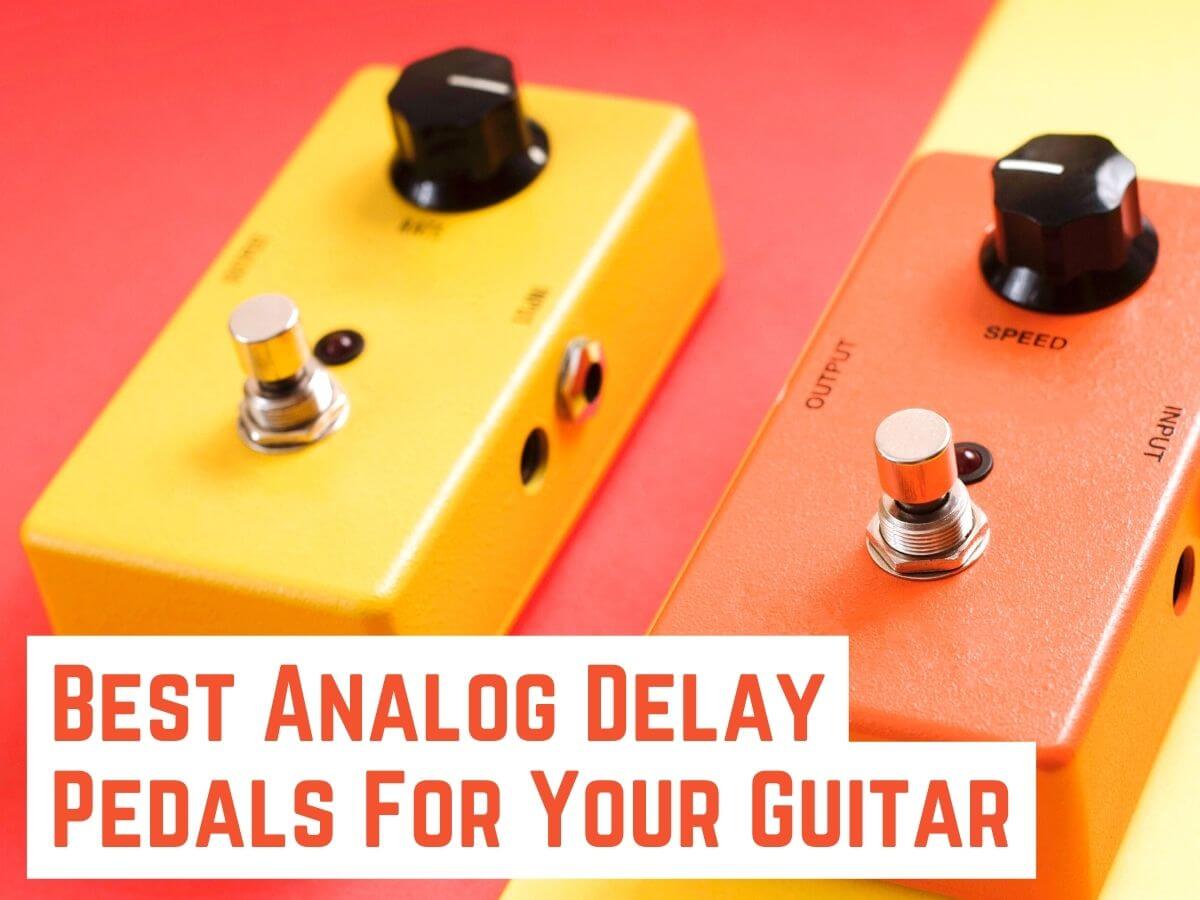
Analog delay pedals have been used by countless guitarists like Slash and David Gilmour to add nuances to their playing. They have a specific flavor that’s not found in digital delays, which is why they’re so loved. But with so many on the market today, it can be quite confusing to choose the one that’ll work for you.
That’s why we’ve researched and compiled this list of the 7 best analog delay pedals that you can buy today.
What are the Best Analog Delay Pedals?
1. BOSS DM-2W Waza Craft Analog Delay Pedal – Best Overall
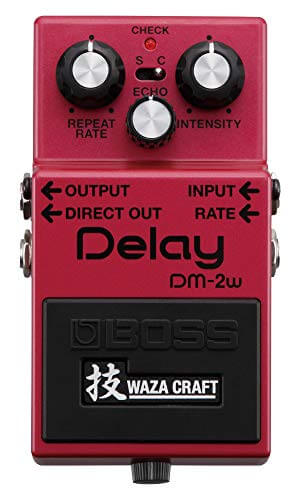
Specifications
- Delay Time: 20-800ms
- Controls: Repeat Rate, Echo, Intensity, Mode Switch
- Bypass: Buffered Bypass
- Power: 9V PSU or Battery
Boss pedals are one of the most popular in the world, used by many famous artists for their renowned quality and incredible sound. The original Boss DM-2 delay, from 1977, was a huge success, used by artists like U2, Kurt Cobain, and many others. The new Boss DM-2W Waza Craft version is a welcome recreation of that iconic sound, along with some handy new features.
The DM-2W has three control knobs for Repeat Rate, Echo, and Intensity, just like the original DM-2. There are two modes available as well: a Standard mode that’s an authentic recreation of the classic analog delay sound with a delay time from 20 to 300 milliseconds, and a new Custom mode that bumps up the delay time to 800ms and offers a more modern delay with a crisp attack. Both of these sound glorious and offer you a range of tonal options. According to Mitch Gallagher of Sweetwater Sound :
It has that original DM-2 sound, but you also get an extended delay time and some nice extended features as well.
Boss has designed the DM-2W exactly like the original DM-2, with the same red finish and a classic stompbox design that’s rugged and compact. The large footswitch is easy to use, and there’s a battery check indicator. There is a mono input, a direct out, a wet output, and a rate input expression control as well. It can be powered by a 9V power supply or battery, and it has a buffered bypass.
If you want those legendary analog delay sounds that have been used by countless artists, then the Boss DM-2W Waza Craft is simply the best option. With two switchable modes that offer both vintage and modern sounds, easy-to-use control knobs, and a compact design, the DM-2W is everything you could need from a recreation of the best analog delay pedal in history.
2. Donner Yellow Fall Vintage Pure Analog Delay – Budget Pick
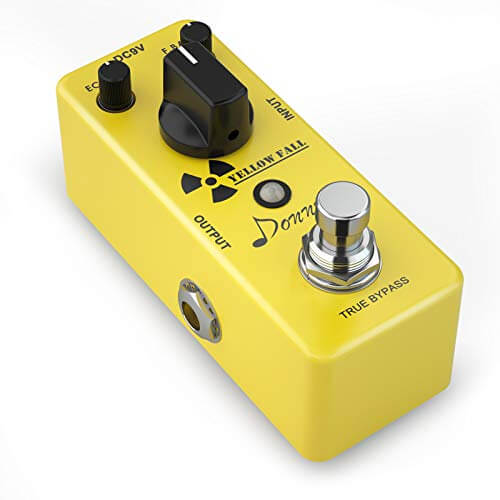
Specifications
- Delay Time: 20-620ms
- Controls: Echo, Time, Feedback
- Bypass: True Bypass
- Power: 9V PSU
Donner pedals have made a name for themselves due to their affordability and surprisingly good quality. The Donner Yellow Fall analog delay is another surprise in their ever-expanding arsenal of guitar effects pedals. The Yellow Fall is a simple analog delay pedal with just a single delay mode and three basic control knobs for echo, feedback, and delay time.
The Yellow Fall’s design and sound are both simple, clean, and pure. The sound of the delay is something of a hybrid between an analog delay and a digital delay. It works exactly as you would expect it to, with a minimum of 20ms of delay time and a maximum of 620ms. There is no unnecessary noise, hum, or distortion in the signal. The control knobs are very easy to use, so your desired delay sound can be configured and achieved very easily.
The Yellow Fall comes in a compact aluminum chassis with a really good build quality for its price. There are mono input and output jacks on the sides, and the pedal is small enough to easily fit on any pedalboard. It also features a true bypass footswitch, and it requires a 9V power supply to function smoothly.
If you’re looking for a simple analog delay effect pedal on a tight budget, then the Donner Yellow Fall fits the bill perfectly. There’s nothing fancy or complex about it; it just works great. It’s simple, compact, easy to use, and sounds good. That’s why it’s the best budget delay pedal, according to us.
3. Electro-Harmonix Deluxe Memory Boy Analog Delay – Most Versatile
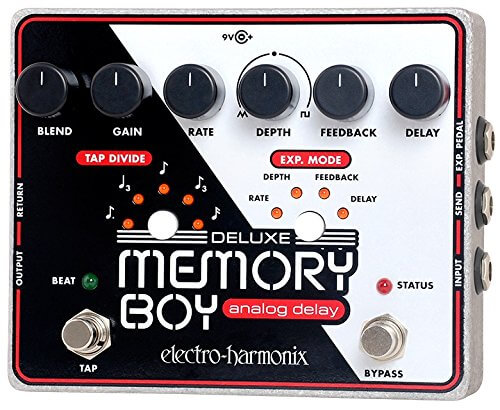
Specifications
- Delay Time: 34-700ms
- Controls: Blend, Gain, Rate, Depth, Feedback, Delay, Tap Tempo
- Bypass: True Bypass
- Power: 9V PSU
Electro-Harmonix pedals have been used by many famous artists for many years now for their reliability and innovative sounds. The original Electro-Harmonix Memory Man was one of the best analog delay pedals, and recently, they revived it with a series of new delay pedals. The Memory Boy Deluxe is their top-of-the-line delay pedal with extensive customizability options and glorious, vintage analog delay tones.
The Deluxe Memory Boy has 6 control knobs on its top for Blend, Gain, Rate, Depth, Feedback, and Delay. These give you insightful control over every aspect of the delay sound, and the Gain knob allows you to add some boost as well. There are even triangle and square-wave modulation effects, allowing you to dial in some chorus or vibrato. And with the Tap Tempo switch, you can easily sync it up to your playing in real-time. The tonal options here are quite endless, to be honest.
The Memory Boy is a hefty pedal and hence requires some space on your pedalboard, but it’s also built like a tank. Besides the input and output, you have expression pedal input, as well as a built-in effects loop so you can customize your signal chain as you wish. The bypass switch engages true bypass, and there are LED indicators to show the current tempo of the delay and power state. It requires a 9V power supply for its smooth operation.
If you’re looking for the most versatile, most customizable, and most pristine all-analog delay tones, then you should definitely go for the Electro-Harmonix Memory Boy Deluxe. With an extensive panel of controls that include tap tempo, tap divide, expression pedal, modulation, and more, along with vintage delay tones using bucket-brigade technology, the Memory Boy Deluxe is a fantastic, modern reincarnation of an iconic pedal.
4. Way Huge Smalls Aqua-Puss Analog Delay
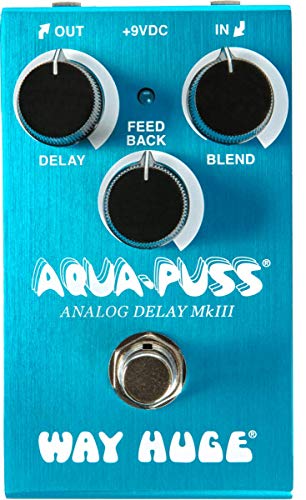
Specifications
- Delay Time: 20-300ms
- Controls: Delay, Feedback, Blend
- Bypass: True Bypass
- Power: 9V PSU or Battery
Way Huge, a Jim Dunlop brand, has been making iconic pedals for several years now, and the original Aqua-Puss was a hit amongst many guitarists, especially country players. The new Way Huge Smalls Aqua-Puss retains all of that same tone goodness in a much smaller stompbox with easy-to-use controls and a simple design.
The Aqua-Puss has three control knobs that adjust Delay, Feedback, and Blend. The delay time here ranges from 20ms to 300ms, which is enough to add some much-needed depth to your tone, the Feedback adjusts the number of echo repeats, and the Blend knob lets you adjust the ratio of the dry and wet signal. The overall delay sound of the Aqua-Puss is bright and jangly, much like the original.
The Aqua-Puss comes in a cool blue finish with an aesthetic, anodized-aluminum chassis that’s both compact and durable. There are mono input and output jacks on the top, and a battery check indicator LED as well. The footswitch is a true hardwire relay, and it can be powered by a 9V power supply or a battery.
If you want some bright analog delay tones with easy-to-use controls, then you should definitely check out the Way Huge Smalls Aqua-Puss. It’s an all-analog pedal with bucket-brigade technology that delivers vintage delay tones in a compact stompbox with a fresh design, making it a great fit for a variety of guitar players.
5. MXR M169 Carbon Copy Analog Delay
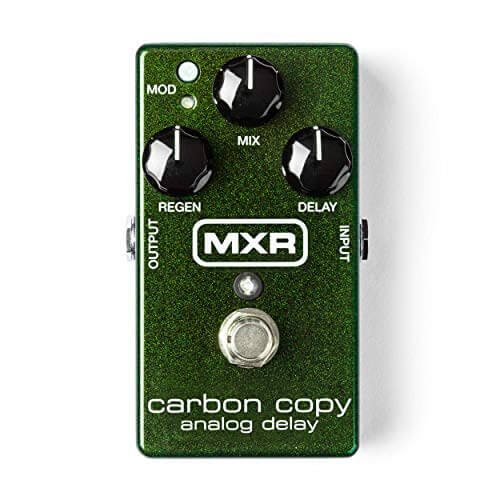
Specifications
- Delay Time: 20-600ms
- Controls: Regen, Mix, Delay, Mod
- Bypass: True Bypass
- Power: 9V PSU or Battery
Another Dunlop brand, MXR pedals are one of the most popular pedals amongst guitarists worldwide for their beautiful tones and simple designs. The MXR Carbon Copy has long been many guitarists’ favorite delay pedal for its warm analog delay tone and road-worthy compact design.
The MXR Carbon Copy has three control knobs to control Delay, Mix, and Regeneration, as well as a Mod switch to add some modulation effects. It offers up to 600ms of delay time, which is enough for some sweet ambient tones, and also thickens up your tone. The modulation effect can also be altered using two internal trim pots that control its width and rate.
The analog delays here sound fantastic, with an old-school flavor that works perfectly with classic rock genres. It works well for country music too, and styles like chicken-picking. If you’re a fan of artists like Pink Floyd and The Beatles, you’ll love the delay sound here. According to guitarist Tom Quayle of Dawsons Music :
It’s a really nice pedal for getting those lush sounds, and also works great as your main delay pedal.
The Carbon Copy has a very compact design with an aluminum chassis that’ll easily fit most pedalboards, but if that wasn’t enough, they have a Mini version of the pedal as well. The input and output jacks are on the side, and there’s a blue LED to show its power state. It has a true bypass, and it can be powered by a 9V power supply or by batteries.
If you want a simple analog delay pedal that easily gets the job done and offers a warm tone, then you should definitely consider the MXR Carbon Copy. With up to 600ms of delay and all-analog audio offering a crisp sound in a rugged design, it’s a pedal that deserves to be on your pedalboard.
6. Behringer Vintage Delay VD400 Analog Delay Guitar Pedal
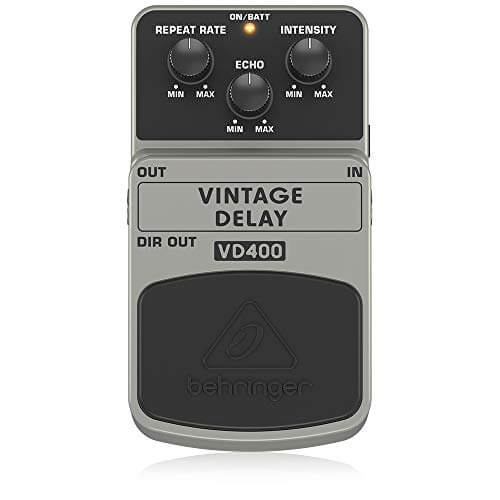
Specifications
- Delay Time: 300ms
- Controls: Repeat Rate, Echo, Intensity
- Bypass: True Bypass
- Power: 9V PSU or Battery
Behringer pedals have recently become quite famous for offering guitarists a lot of value for their money, due to their surprisingly good quality and affordability. The Behringer VD400 is an all-analog bucket-brigade delay pedal inspired by legends like the Boss DM-2, and provides a great sound with a good design.
The VD400 has three control knobs on its front to adjust Repeat Rate, Echo, and Intensity. These are simple controls, but they offer versatility, and the maximum delay time goes up to 300ms here. It has a warm tone to it, and you can use it for a variety of genres as you please. There is no noise in its operation, and your dry signal retains its clarity and integrity.
The VD400 has a plastic build, but it’s rugged and compact so it’ll easily fit in any pedalboard. Besides the input and output jacks, there is a direct out jack for a stereo delay effect, and a battery check indicator as well. It has a true bypass, and it can be powered by a 9V power supply or a battery.
The Behringer VD400 is another budget option to consider for guitar players looking for a simple and affordable way to expand their pedalboard. With classic analog delays and a clean and efficient design, the VD400 punches well above its weight, offering competition to much more expensive pedals.
7. Seymour Duncan Vapor Trail Analog Delay Guitar Pedal
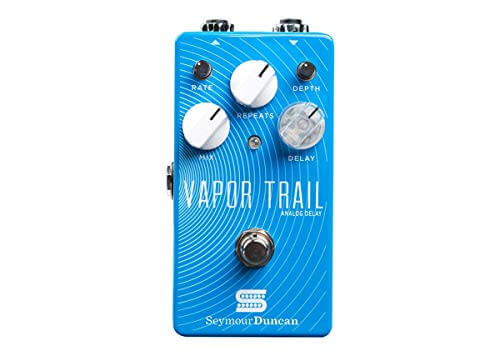
Specifications
- Delay Time: 15-600ms
- Controls: Mix, Repeats, Delay, Rate, Depth
- Bypass: True Bypass
- Power: 9V PSU or Battery
Seymour Duncan, though most well-known for producing pickups, also makes a range of high-quality guitar effects pedals. The new Vapor Trail analog delay pedal is one of their latest releases and is designed to reproduce authentic, vintage delay sounds with an all-analog circuitry in a modern and sleek design with hands-on control.
The Vapor Trail has large knobs to control the Mix, Repeats, and Delay, as well as smaller knobs for the Rate and Depth of the modulation effect. The delay time has a range from 15ms up to 600ms, and there’s a blue LED that flashes to the delay tempo, making it easy to visualize how fast the delay is. The modulation can be controlled as necessary too, adding a nice chorus effect to the delayed tone.
The Vapor trail has a sky-blue finish with a metal chassis that’s both compact and durable, and will easily find its place on your pedalboard. The interesting thing is that it also contains an insert FX jack, so you can combine it for stereo outputs, expression pedal input, or other interesting combinations. There’s a true hardwire bypass footswitch, and it can be powered by a 9V power supply or battery, which is easily accessible without any screws.
If you’re looking for an innovative analog delay effect, then you should certainly consider the Seymour Duncan Vapor Trail. It’s an analog delay that offers the warmth of vintage tones, but with modern features and a range of versatile controls in a compact stompbox that would make you feel remiss to not have on your pedalboard.
What To Know Before Buying a Analog Delay Pedal?
Here are some important considerations about analog delay pedals that you should keep in mind before you buy one:
Sound And Delay Time
When choosing an analog delay pedal for yourself, the most important factor is obviously its sound. Analog delays have a characteristic sound compared to digital delays, which is why many guitarists prefer them despite their lack of versatility. Analog delay pedals generally use bucket-brigade (BBD) chips, which is why their delay time generally maxes out at a few a hundred milliseconds .
Analog delay pedals have warmth in their tone, whereas digital delays are brighter.
Even amongst analog delay pedals, there are a lot of characteristic tonal differences due to different internal circuitries and the settings available. The maximum delay time available on any pedal on this list is 800ms, which is enough for ambient soundscaping, but also works well for guitar solos and leads. We recommend trying out different pedals at a local store if you can, so you can see what sounds best to your ears.
Controls And Power Requirements
The control options available on analog delay pedals vary, but some of the most commonly found knobs include Delay (to set the delay time), Feedback (to set the number of repeats), and Mix (to adjust the ratio of wet and dry signal). Sometimes manufacturers give different names to these same functions, and some pedals, like the EHX Memory Boy Deluxe, have a ton of control options to customize your tone extensively.
So the question here is for you to decide whether you want a simple pedal that’ll just plug in and be ready to play without too much tinkering, or you want to customize your tone to perfection with as many control options as possible.
The power requirements can be a concern as well. While most delay pedals tend to have an option to run on 9V batteries, some can run only through power supplies, and some might have specific power requirements too. So based on your pedalboard setup, and your usage case (especially if portability is important for you), make sure you get a pedal that’ll work for you wherever you go.
Bypass
Most analog delay pedals have true bypass, as this ensures that your guitar’s authenticity is not lost in any way when the effects pedal is bypassed, and it results in a smooth operation. But true bypass can also be problematic when used with long cable lengths and large pedalboards, as the high-impedance signal from your guitar will face resistance and start to lose some high-end frequencies.
True bypass works best for smaller pedalboards with short cables, where there is no chance of top-end frequency loss.
To prevent this frequency loss, buffered bypass pedals will convert your guitar signal into a low-impedance signal, hence acting as a ‘buffer’. In certain situations, this is more helpful, and ensures that the signal’s integrity is maintained, and no ‘tone-sucking’ occurs.
Hence you should pick a pedal according to your pedalboard size, to ensure that you don’t encounter any unnecessary tone losses.
FAQs
What is the best delay pedal?
The best delay pedal, according to us, would be the Boss DM-2W Waza Craft. It’s an all-analog delay that’s based on the iconic DM-2, and with two different modes, you get a range of versatile delay sounds that can work in a variety of situations. The build quality is excellent, and its pricing is very competitive as well.
How do you use analog delay?
You should use an analog delay near the end of your signal chain. Place it after any overdrive or other gain effects, and before reverb, so that it affects your fully-processed signal. Set the delay time, feedback, and intensity as you like it, and then jam to your favorite songs! Delays can be used for guitar solos, leads, rhythmic slapping, sonic landscaping, ambient chords, and much more, so use your imagination.
When should you use a delay pedal?
You should use a delay pedal whenever you want a thicker sound with multiple repeats and echoes. Guitarists often use it during guitar solos, as it basically doubles your signal and makes it cut through the mix very easily. By adding a lot of repeats, you can use it for ambient chords and specific patterns. A tap tempo switch helps sync the delay up to your song, and you can use it for even more interesting purposes.
